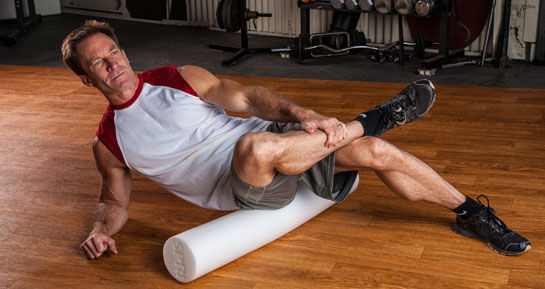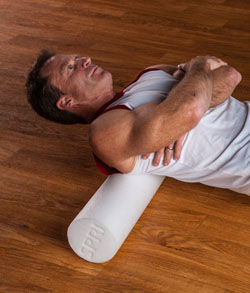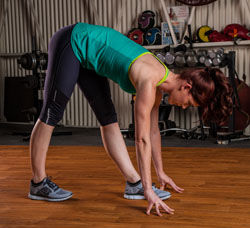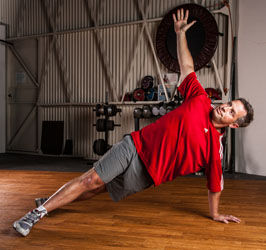
By Eric Bach
Whether you’re providing a 30-minute session for a deconditioned client or a two-hour workout for a professional athlete, a comprehensive warm-up should be an essential component of all your clients’ programs. When properly implemented, a well-designed warm-up will maximize performance in two ways:
- Improve the physiological response to exercise
- Improve psychological focus
This article provides detailed guidelines on how to properly prepare a client’s body and mind for a maximally efficient training session. Also included are sample protocols for several different activities and clients, including the weekend warrior or recreational athlete.
The Basics
When analyzing the warm-up needs of a specific client, your first step is to answer the following questions:
- What energy systems are utilized in the sport or activity for which the client is training?
- What are the client’s movement deficiencies?
- Are there common injury sites that need to be preventively addressed?
Once these questions are answered, you can begin pre-workout activities, which include techniques for addressing (Boyle, 2010):
- Tissue density (myofascial release and foam rolling techniques)
- Tissue length (stretching)
- Tissue/neuromuscular readiness (dynamic drills and tissue activation)
Tissue Density
Tissue density can be addressed through multiple forms of myofascial release, including high-density foam rollers and tennis balls. By addressing muscular density in a warm-up, clients can decrease trigger points and knots (adhesions) within muscles, which will lead to improved mobility and movement quality. When examining the efficacy of myofascial release, Mike Boyle, a sports and conditioning coach and author of Advances in Functional Training, offers this analogy: Picture a band with a knot in it. As you stretch, you are pulling the band apart and simultaneously tightening the knot. Attacking tissue density with myofascial release works to untie the knot before stretching ensues (Boyle, 2010).
Whether your client is a desk jockey or an elite athlete, improving movement quality and mobility around key areas such as the ankles, shoulders and hips is vital for injury prevention.
Tissue Length
Tissue length is addressed through the use of static stretching, which elicits an acute increase in flexibility. This is beneficial, as the increase in range of motion allows better movement quality for the ensuing workout. Some evidence has suggested that static stretching prior to athletic performance does not decrease injury and can, in fact, decrease power production and thus performance (Samuel et al., 2008; Thacker et al., 2004). These results, however, are far from conclusive, as other studies have found no reduction in power-productive capabilities related to static stretching (Alpkaya and Koceja, 2007).
Whether or not static stretching results in decreased power output, it still can play a vital role in corrective exercise and keeping clients healthy, which is essential for optimal performance. In addition, it is possible to counter the potential for decreased power production by incorporating static stretching prior to performing tissue-readiness activities (described below), as these dynamic drills activate the nervous system before the workout, negating any dampening potentially caused by static stretching. Furthermore, nearly all athletes and clients need some static stretching to address common postural deficiencies that put them at greater risk of injury.
Tissue/Neuromuscular Readiness
Once tissue length and density have been addressed, neuromuscular and tissue readiness can be achieved through active mobility drills (which increase the range of motion of a joint) and dynamic warm-up drills. Dynamic warm-ups elicit both short- and long-term increases in performance (Herman and Smith, 2008).
Warm-up and Training Time Constraints
Training time is often a limiting factor when developing effective programs for your clients. However, an effective warm-up can be completed in 12 percent to 20 percent of session time, or in eight to 12 minutes of an hour-long session. Once your clients become familiar with proper techniques, they can begin foam rolling and static stretching on their own before sessions to allow more time for training and exercise instruction.
The dynamic portion of the warm-up incorporates active stretching techniques, sport-specific movement integration, and neural activation exercises. These modalities are performed to mimic the movement-specific demands of the activity, address movement deficiencies, increase core and ligament temperature, stimulate the nervous system, increase stability, and activate proprioceptors (Yauss and Rotchstein, 2011). These drills will allow for the technical rehearsal of activity-specific movement patterns and, as a result, a reduced risk of musculoskeletal injuries.
Sample Programs
The following sample warm-up programs involve myofascial release techniques, methods to improve flexibility and dynamic movements to develop proper movement patterns while activating the neuromuscular system in preparation for activity. All exercises listed in these sample programs are included in the exercise descriptions that follow.
Sample Warm-up 1: High School Hockey or Lacrosse Player

Tissue Density (1 x 8–10):
- Foam roll thoracic spine
- Foam roll chest
- Foam roll adductors
- Piriformis myofascial release
Half-kneeling hip flexor stretchTissue Length (2 x 10 seconds per stretch):
- Chest stretch
- Shoulder capsule stretch
- 3-D hamstrings stretch
Tissue/Neuromuscular Readiness:
- Star lunge (1 x 5)
- Band dislocations (1 x 10)
- Reverse cross lunge (1 x 10 per leg)
- Hurdle hip mobility (1 x 10 per side)
- Medicine ball side toss (1 x 5 per side)
- Side-to-side skater jumps (1 x 5 per leg)
Sample Warm-up 2: Basketball

Tissue Density (1 x 8–10):
- Foam roll lower leg
- Foam roll IT band
- Foam roll thoracic spine
- Piriformis myofascial release
Tissue Length (2 x 10 seconds per stretch):
- Calf
- Sprinter hamstrings stretch
- Half-kneeling hip flexor stretch
Tissue/Neuromuscular Readiness:
- Wall ankle mobility (1 x 10 each ankle)
- Star lunge sequence (1 x 5)
- Jump rope (50)
- High-knee run (2 x 10 meters)
- Depth jumps (2 x 5)
Sample Warm-up 3: Weekend Warrior, Recreational Runner or Cyclist

Tissue Density (1 x 6–8):
- Foam roll IT band
- Foam roll lower leg
- Piriformis myofascial release
- Foam roll hamstrings
- Foam roll thoracic spine
Tissue Length (2 x 10 seconds each stretch):
- Sprinter hamstrings stretch
- Standing quadriceps stretch
- Chest stretch
Tissue/Neuromuscular Readiness:
- Birddog (1 x 30 seconds per side)
- Fire hydrant circles (1 x 10 each direction)
- Hurdle hip mobility (1 x 10 each side)
- Band dislocations (1 x 10)
- T-bar push-up (1 x 10)
- Medicine ball back toss (1 x 5)
- Body-weight jump squat (1 x 5)
Myofascial Release Exercises
Foam Roll IT Bands: Lie on your side and roll each IT band slowly from the lateral epicondyle of the hip to the lateral side of the distal femur.
Foam Roll Adductors: Angle the foam roller on the inner thigh just below the pubis and roll down and over the adductor muscles to just above medial aspect of the knee.

Foam Roll Thoracic Spine: Lay supine on a foam roller, abduct the scapula by wrapping your arms around your torso. Roll up and down the thoracic spine, while keeping the feet firmly on the ground.
Foam Roll Chest: Place a tennis ball against a wall and lean the chest into the ball below the lateral aspect of the clavicle and apply circular pressure into the pectoralis major.
Piriformis Myofascial Release: Sit on the ground with the right leg crossed over the left. Bend the left leg while placing the tennis ball underneath the right glute. Roll the tennis ball in a circular motion on the gluteal muscle.
Myofascial Release Lower Leg: Place a foam roller under the calf and perform rolls over the lateral, posterior and anterior aspects of the lower leg.
Tissue Length/Flexibility Exercises

Sprinter Hamstrings Stretch: From a kneeling position with the right leg up, put the left knee alongside the instep of the right foot. Place the hands on the ground and stand up as high as possible into a sprint stance, while keeping both feet flat on the ground.
Half-kneeling Hip Flexor Stretch: Kneel with the left knee and the right foot on the floor. Lean forward while rotating to the right and reaching up with the left hand.
Chest Stretch: Stand facing a doorframe; angle the left arm up to 45 degrees and place on the doorframe. Step forward with the right leg and lean into the stretch.
3-D Hamstrings Stretch: Elevate one foot with the toes pointed up on a bench or chair at roughly waist height. (Note: For clients with limited mobility, a lower height is fine.) Lean forward and bring the bellybutton toward the knee to stretch the hamstring. Return to standing and repeat the stretch, but this time lean toward the lateral aspect of the hamstring. Return to standing and repeat the stretch, but this time push the hips back and stretch the medial aspect and groin of the elevated leg.
Shoulder Capsule Stretch: Lie on one side with the upper arm angled 45 degrees to the body. Gently push down on the hand of the angled arm as low as possible.
Tissue Readiness/Dynamic Warm-up
Birddog: From a quadruped position, extend the opposite arm and opposite leg in a slow and controlled fashion, maintaining neutral spine for the duration of the set.
Band Dislocations: Stand and, with both hands, hold a light resistance band taut in front of the shoulders. Pull the band apart while bringing the outstretched arms overhead and behind the body, then back in front of the shoulders.
Fire Hydrant Circles: From a quadruped position, lift the bent knee out to the side while maintaining neutral hips. From this position, perform one set of circles, 10 repetitions in each direction.

T-bar Push-up: From a push-up position, perform a full push-up. During the concentric phase of the push-up, rotate the torso and hips concurrently while making a T with the upper body. Rotate and lower the body back to the ground and repeat on the opposite side.
Star Lunge: Perform a forward lunge with each leg, a lateral lunge with each leg and then a reverse rotational lunge with each leg. This series is considered one repetition.
Hurdle Hip Mobility: Lean into a wall with the arms fully extended. Extend the leg backward, and then laterally abduct and rotate the hip up toward chest level (or as high as possible).
Reverse Cross Lunge: Perform a reverse lunge with the lunging leg crossing behind the forward leg. Return to standing position and repeat.
Medicine Ball Side Toss: Stand sideways to a wall and hold a medicine ball extended away from the body at chest height. Rotate the whole body backward and then quickly switch directions, throwing the ball as hard as possible into the wall. Pick up the ball and repeat for desired reps.
Medicine Ball Back Toss: This exercise is best performed outdoors with plenty of space. Assume an athletic stance and hold a medicine ball at waist height. Using an explosive movement, throw the ball up and over behind the head for height and distance.
Side-to-side Skater Jumps: From an athletic stance, dip low and jump laterally, landing on the right foot. Load up the right foot and explode laterally and land on the left foot. Repeat for desired reps.
Wall Ankle Mobility: Stand in a split stance, roughly 6 inches from a wall. Keep the front heel planted and move the knee as far over the toes as possible and then return to the starting position.
High-knee Run: With proper upper-body sprinting movement, drive the knees up as high as possible as quickly as possible with feet landing directly underneath the torso. Aim for maximum reps within the desired distance.
Depth Jump: Begin standing on a box. Hop off onto the ground, immediately reverse momentum and jump as high as possible.
Putting It All Together
Activity-specific warm-ups are designed to properly prepare the body for physical activity and sharpen mental focus for the activity at hand. Addressing common issues such as tissue density, tissue length, flexibility and mobility at the beginning of a training session reinforces the fact that movement quality and injury prevention are essential to achieving athletic and wellness goals. By concluding the warm-up with dynamic stretching and neuromuscular activation drills, clients gain the advantage of a routine that can help reduce injury risk, improve muscular tissue density and flexibility, activate proprioceptors and deep stabilizers, enhance movement quality, and improve performance through the creation of more efficient and powerful movement patterns (Shellock and Prentice, 1985).
References
Alpkaya, U. and Koceja, D. (2007). The effects of acute static stretching on reaction time and force. Journal of Sports Medicine and Physical Fitness, 47, 147–150.
Boyle, M. (2010). Advances in Functional Training (ebook). Aptos, Calif.: On Target Publications.
Herman, S.L. and Smith, D.T. (2008). Four-week dynamic stretching warm-up intervention elicits longer-term performance benefits. Journal of Strength and Conditioning Research, 22, 4, 1286–1297.
Samuel, M. et al. (2008). Acute effects of static and ballistic stretching on measures of strength and power. Journal of Strength and Conditioning Research, 22, 5, 1422–1428.
Shellock, F.G. and Prentice, W.E. (1985). Warming up and stretching for improved physical performance and prevention of sports-related injuries. Sports Medicine, 2, 4, 267–278.
Thacker, S. et al. (2004). The impact of stretching on sports-injury risk: A systematic review of the literature. Medicine in Science & Sports & Exercise, 36, 3, 371–378.
Yauss, B. and Rotchstein, A. (2011). The acute and chronic benefits of movement prep for the soccer athlete. NSCA's Performance Training Journal, 10, 3, 1116.
___________________________________________________________________________
 Eric Bach, B.S., C.S.C.S., is a strength and conditioning coach and author at Forza Fitness and Performance Club in Denver, Colo. As part of an elite training team, Eric specializes in sports-performance training and strength sports. Follow him on Twitter at Eric_Bach or www.ericbachperformance.wordpress.com.
Eric Bach, B.S., C.S.C.S., is a strength and conditioning coach and author at Forza Fitness and Performance Club in Denver, Colo. As part of an elite training team, Eric specializes in sports-performance training and strength sports. Follow him on Twitter at Eric_Bach or www.ericbachperformance.wordpress.com.